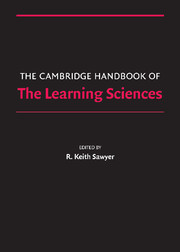Book contents
- Frontmatter
- Contents
- Preface
- Contributors
- 1 Introduction
- PART I FOUNDATIONS
- 2 Foundations and Opportunities for an Interdisciplinary Science of Learning
- 3 Constructionism
- 4 Cognitive Apprenticeship
- 5 Cognitive Tutors
- 6 Learning in Activity
- 7 Knowledge Building
- PART II METHODOLOGIES
- PART III THE NATURE OF KNOWLEDGE
- PART IV MAKING KNOWLEDGE VISIBLE
- PART V LEARNING TOGETHER
- PART VI LEARNING ENVIRONMENTS
- Afterword: After How Comes What
- Epilogue: The Fundamental Issue in the Learning Sciences
- Author Index
- Subject Index
- References
2 - Foundations and Opportunities for an Interdisciplinary Science of Learning
Published online by Cambridge University Press: 05 June 2012
- Frontmatter
- Contents
- Preface
- Contributors
- 1 Introduction
- PART I FOUNDATIONS
- 2 Foundations and Opportunities for an Interdisciplinary Science of Learning
- 3 Constructionism
- 4 Cognitive Apprenticeship
- 5 Cognitive Tutors
- 6 Learning in Activity
- 7 Knowledge Building
- PART II METHODOLOGIES
- PART III THE NATURE OF KNOWLEDGE
- PART IV MAKING KNOWLEDGE VISIBLE
- PART V LEARNING TOGETHER
- PART VI LEARNING ENVIRONMENTS
- Afterword: After How Comes What
- Epilogue: The Fundamental Issue in the Learning Sciences
- Author Index
- Subject Index
- References
Summary
In this chapter, we argue that the learning sciences are poised for a “decade of synergy.” We focus on several key traditions of theory and research with the potential for mutually influencing one another in ways that can transform how we think about the science of learning, as well as how future educators and scientists are trained.
The three major strands of research that we focus on are: (1) implicit learning and the brain, (2) informal learning, and (3) designs for formal learning and beyond. As Figure 2.1A illustrates, these three areas have mainly operated independently, with researchers attempting to apply their thinking and findings directly to education, and with the links between theory and well-grounded implications for practice often proving tenuous at best.
The goal of integrating insights from these strands in order to create a transformative theory of learning is illustrated in Figure 2.1B. Successful efforts to understand and advance human learning require a simultaneous emphasis on informal and formal learning environments, and on the implicit ways in which people learn in whatever situations they find themselves.
We explore examples of research from each of these three strands. We then suggest ways that the learning sciences might draw on these traditions for creating a more robust understanding of learning, which can inform the design of learning environments that allow all students to succeed in the fast changing world of the twenty-first century (e.g., Darling-Hammond & Bransford, 2005; Vaill, 1996).
- Type
- Chapter
- Information
- The Cambridge Handbook of the Learning Sciences , pp. 19 - 34Publisher: Cambridge University PressPrint publication year: 2005
References
- 12
- Cited by



